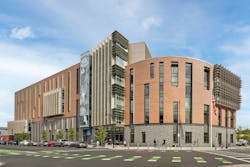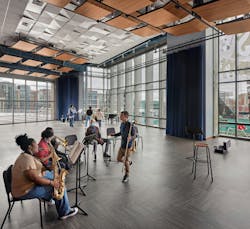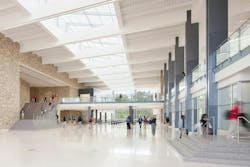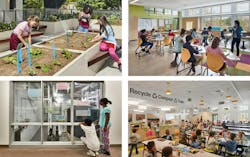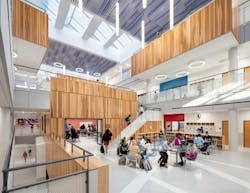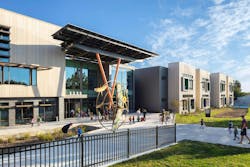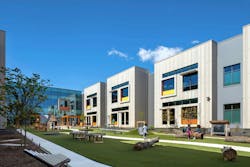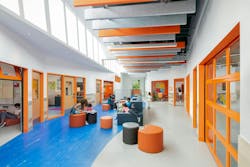From net zero to net positive in K-12 schools
Less than a year after its opening last September, The AIA has recognized the new Boston Arts Academy with an Education Facility Design Award for its state-of-the-art learning environment. “This is not just a laboratory but a vehicle for high performance that provides a wealth of opportunities for students. It’s an incredible asset for the Boston public school system,” the award jury wrote.
For the K-12 practice at Perkins Eastman, the honor is the latest in a string of awards for schools, both nationally and internationally, that embrace our designers’ mission to pair sustainability with educational outcomes. We’ve trademarked a name for the dual pursuit of dramatic energy reduction and high-performance learning environments: Net Positive Education.
And as the nation has just observed its 21st annual National Healthy Schools Day, which promotes indoor environmental quality in America’s schools, we’re sharing a new section of our website that demonstrates our commitment to this cause. By reaching for high-performance design, we’ve shown across multiple K-12 projects that this can positively impact indoor environmental quality and student and teacher satisfaction—which ultimately can impact health, happiness, and performance in a learning environment.
Net Positive Education Benefits
The benefits cut across four key environmental factors:
The new Boston Arts Academy, across the street from Boston’s famed Fenway Park, places a high priority on daylight with reduced heat gain and glare; great acoustics; healthy indoor air quality and high-performing mechanical systems; and a tight building envelope. Perkins Eastman’s Design Research and Sustainability teams conducted a pre-evaluation on the old warehouse that once housed the school on this site; they’ll also perform a post-occupancy evaluation in the new building this fall for a report comparing the “before and after” conditions. But other schools are already offering evidence of Net Positive Education.
Since Washington, D.C., Mayor Muriel Bowser cut the ribbon to open John Lewis Elementary School in August, 2021, the children passing through its doors have been treated to a design that’s on track to become the first school in the world to achieve a trifecta of net zero energy, LEED Platinum, and WELL.
These certifications speak to the quality of the indoor environment, the efficiency of its mechanical systems and energy use, its daylighting and indoor-outdoor flow, its acoustics, and the security and well-being of those who use the building. Learning by Design magazine promptly awarded it with its Citation of Excellence shortly after its opening.
A post-occupancy evaluation at John Lewis was performed in March to measure data points such as acoustic levels, air temperature, and daylight that can quantify those first impressions. But we already know what kind of measurable benefits result from high-performance, sustainable educational environments:
Dunbar Senior High School
Dunbar Senior High School, also in the district, was the first new-construction school in the world to achieve LEED Platinum when it opened in 2017. Post-occupancy studies showed that after students moved into the new building, they achieved the highest test-score gains of any high school in the city. Enrollment and graduation rates also increased.
The Dr. Martin Luther King, Jr. School
The Dr. Martin Luther King, Jr. School in Cambridge, Mass, achieved LEED Platinum after it opened in 2015. Studies there also showed soaring scores on students’ satisfaction with its design features, their sense of community and pride, indoor environmental quality, pedagogical support, and safety. “These healthy, high-performance learning environments are suffused with natural light, they have wonderful acoustics, they have great indoor air quality, they’re comfortable, and they really foster opportunities to engage in education and support the learning process,” K-12 Practice Leader Principal Sean O’Donnell says.
Benjamin Banneker Academic High School
Benjamin Banneker Academic High School in Washington, D.C., was designed in concert with John Lewis so they both benefitted from these precedents. It opened in 2021—within days of John Lewis—offering a collegiate-like environment to the city’s celebrated magnet program for its most gifted students.
The Conclusions Are In
We’ve designed dozens of school modernizations over the past decade while constantly asking the question, “What is the connection between the built environment and educational outcomes?” There are many answers that point to these twin benefits of indoor environmental quality and student performance, as we’ve discovered through studies such as Investing in our Future: How School Modernization Impacts Indoor Environmental Quality and Occupants.
From a budget standpoint alone, taxpayers stand to save millions when schools become more energy efficient—and that money can be redirected toward educating their children. At Washington, D.C., Public Schools (DCPS), energy costs rank as the system’s second-largest investment, behind only the salaries of its 10,000 employees. That means more money goes toward heating, cooling, and lighting than things like computers and educational materials, Perkins Eastman Principal Patrick Davis has said. And he should know: Davis was the chief operating officer of DCPS before coming to Perkins Eastman as a strategic consultant for the K–12 practice area.
From a design standpoint, students who attend schools that have cleaner air, more natural light, a steady, comfortable temperature, and learning spaces with better acoustics are more likely to process information and perform at higher levels than their peers in non-modernized buildings.
John Lewis Elementary in particular represents the culmination of lessons we’ve learned through our long partnership with DCPS.
The two-story, 90,000-sf building offers 32 classrooms for students in pre-Kindergarten through fifth grade. A grand entry canopy doubles as a photovoltaic array, generating energy to offset the school’s grid use; more solar photovoltaics are currently being installed across its roof.
Enhanced ventilation, 30% better than the minimum code requirement, helps flush out the buildup of carbon dioxide, which improves kids’ cognition and energy. A deep-well geothermal system keeps the building’s temperature in check, reducing the energy demanded to maintain comfort throughout the year by taking advantage of the earth’s constant temperature.
The building’s orientation, furthermore, and the placement and shading of its windows and skylights ensure a maximum amount of natural light while also preventing unnecessary glare and heat from direct sun.
Garage doors enclose the classrooms—a fanciful element for students and teachers that harkens back to a beloved feature of the original building, but one that also provides a noise barrier from the outside corridors. “Allowing for that acoustic separation,” said architect Janice Szymanski, the executive program manager for DCPS’ modernizations and large capital construction division, in a video about the school. But then opening the doors so the classes can spill into a common space and learn together, she added, “is only going to set them up for success.”
Less visible—or not visible at all, rather—are the out-of-the-way placements of mechanical systems and ductwork, which further cuts down on unwanted ambient noise.
By designing so many schools of this kind—and studying a national energy database that tracks schools across the country—we’ve learned much about designing to reach low targets around energy use intensity (EUI). John Lewis is targeting an EUI of 22 kBTU per square foot each year, which is well below the average of a typical school. The intent is that these reductions in energy consumption, plus the use of roof-mounted, energy-producing photovoltaics that are currently being installed, will allow the project to reach net zero energy.
Through this research and experience we’ve realized that we cannot continue to address our issues in silos. We can’t focus simply on energy or wellness, but rather, we need to look at everything more holistically, and hone in on strategies that support our goals. That’s why we’ve assembled multiple sustainability rating systems and targets to allow us to address higher performance more broadly:
- Net Zero Energy: a dramatic energy reduction paired with renewables targets wellness of the planet
- LEED: this holistic standard targets both wellness of people as well as the planet
- WELL Building Standard: Goes beyond LEED to focus on wellness of people more comprehensively
Net Positive Education is also designed to let everyone in on the action. An interactive digital dashboard greets students, staff, and visitors in the John Lewis lobby—and is also visible online—where they can see the building’s energy consumption and generation in real time. It also allows them to explore larger topics such as water conservation and climate change. Says Juan Guarin of Perkins Eastman’s sustainability team: “Whatever we do in the design, we try to make sure it gets implemented into the educational curriculum.”
The next step in the evolution of Net Positive Education is the completion of a broad survey funded by the Latrobe Prize—a $100,000 grant from the American Institute of Architects’ College of Fellows, awarded every other year to a firm “for research leading to significant advances in the architecture profession.” The Perkins Eastman grant, shared with Drexel University’s School of Education, is funding further investigation “to advance the knowledge of how well-designed educational facilities positively impact students.” The final report, expected this summer, will expand our scope of school design beyond indoor environmental quality to include educational adequacy and community connectivity.
John Lewis’ energy-generating capabilities are such that, if needed, it can share energy with nearby Benjamin Banneker Academic High School, which Perkins Eastman designed and built at the same time, and which is also net-zero-energy ready. “Projects like these are our dream projects,” K–12 Practice Area Leader and Principal Sean O’Donnell said in an article on the topic for Perkins Eastman’s magazine, The Narrative. “We have built our practice over the past 20 years to help our clients and our communities create amazing places to learn.”
